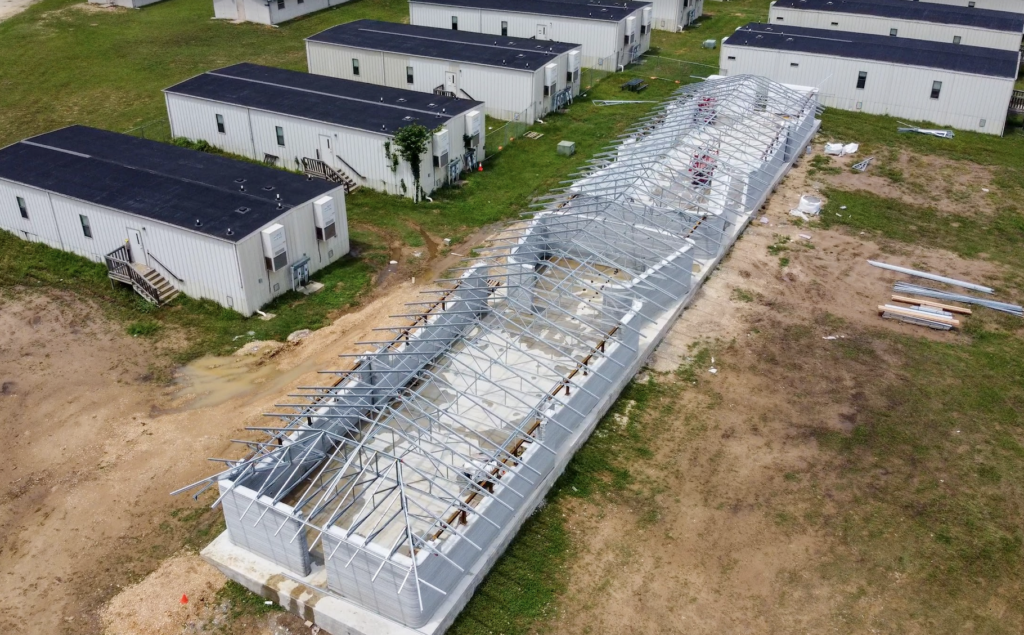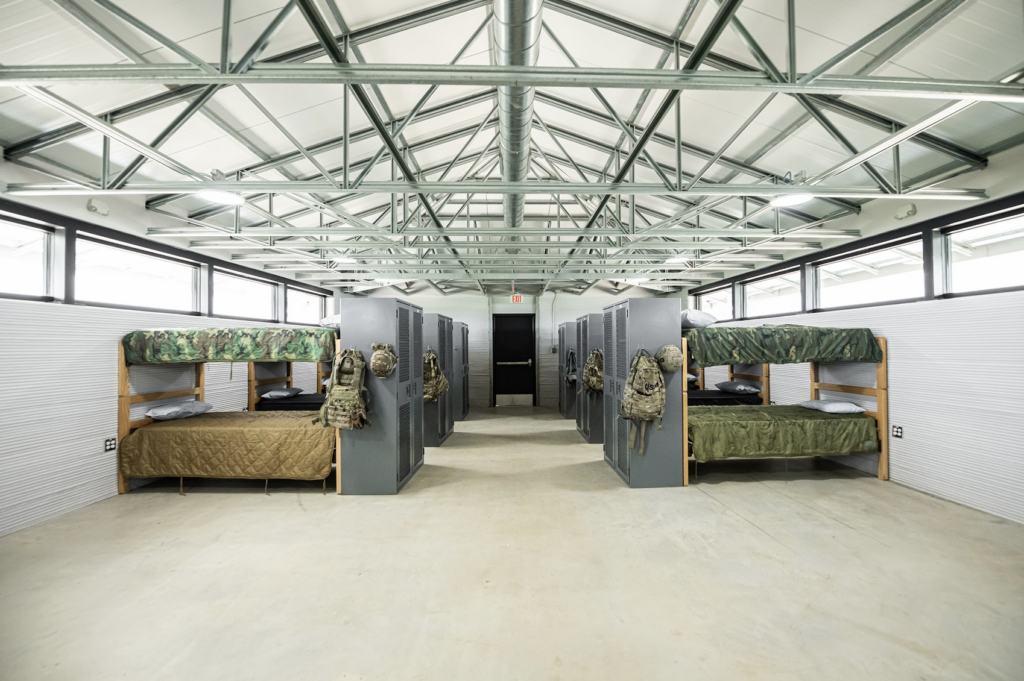The United States military has a high interest in 3D printing for construction. It is researching swarm construction, has awarded $3.2 million to research better concrete for 3D printing, funded hempcrete, printed barracks with ICON, built shelters for vehicles and has constructed some of the largest 3D printed concrete structures worldwide. The U.S. military, especially the Army, seems intent on a developing a comprehensive program for concrete for 3D printing, standards, paths to qualification, real-life testing, and structures that work. The US is ahead of the world in 3D printing for construction. In fact the only other military that is doing anything remotely interesting is the Indian one that is 3D printing barracks and shelters.
Why Does It Make Sense for the Military to 3D Print Buildings?
 ICON’s 3D printed military barracks for the Texas Military Department in progress. Image courtesy of ICON.
ICON’s 3D printed military barracks for the Texas Military Department in progress. Image courtesy of ICON.The US military builds a lot of buildings generally. The US military spends over $10 billion a year on construction. So any marginal gains there give them outsized improvements and savings. At the moment the US military is pivoting towards Asia and confronting China. This means that it will construct multiple bases overseas. Any increase in speed or reduction in cost will aid these efforts. The military does not like to use foreign suppliers, contractors or components lest they be filled with bugs for example. The military likes to standardize everything and replicate its efforts continuously. For such an organization, push button construction is an attractive proposition. Besides 3D printing purely military buildings the US military spends a considerable amount of family housing for its military families. If this is poor quality it reflects poorly on the military, may reduce morale, may cause people to leave the military for other opportunities and may reduce the attractiveness of the military as an employer. Meanwhile inexpensive high quality housing that families like will help recruitment and retention.
Wartime Printing
 Inside ICON’s 3D printed military barracks for the Texas Military Department. Image courtesy of ICON.
Inside ICON’s 3D printed military barracks for the Texas Military Department. Image courtesy of ICON.When constructing under the gun, speed is of the essence. The sooner a base can be set up the sooner the military can move in large numbers of troops and dominate a certain area. The quicker it can repair damaged structures, the faster it can restore the proper running of a base. When overseas, each additional person requires food, water, as well as troops to protect them and their food, water and supply lines. By some calculations, for every frontline soldier, there could be six people supplying or supporting that individual. So if the military can reduce the amount of things it ships overseas, it can reduce the number of personnel, as well as their associated protectors and supplies. It’s possible that, for the same amount of money, an armed force could double the number of frontline soldiers through simplifying or cutting the fat in the supply chain. This means that fewer goods and more of the same helps considerably. For this reason, one machine and some binder combined with local material would be a huge advantage for the military.
At exposed forward operating bases (FOBs), risks are compounded, so having personnel present is extra complex and expensive. In some cases, a frontline soldier could cost the US military $1 million a day to support. Therefore, automated construction could make extra sense for FOBs. Shipping mix or some of the components for the concrete would reduce a lot of weight, as well.
Space is at a premium at FOBs. If a military had extra bunks or shelters, it would probably want to jam in some infantry or a forward air controller. In turn, there isn’t a large opportunity to send in construction crews to the most exposed locations. This means these troops have to live in container homes or in wood structures often for months. Also, if we look at how the U.S. military constructs forward housing, it usually involves a lot of guys walking around with hammers. Such inefficiency relies on too many people and results in this plywood housing.
3D printed concrete barracks could be safer, better thermally insulated, faster to build, require less labor and less SKU. More SKU, or stock items, increases supply chain complexity and potential errors. Better thermal insulation is not only more comfortable, but it may save a lot of money and fewer deployed troops because it may mean less fuel sent to the base.
Finally, cost and risks are compounded when FOBs under assault or are located in very dangerous areas. In those scenarios, using 3D printers could reduce the potential for casualties.
The Green Military
Whereas the Army is already green in color, it has a desire to be green in its relationship with nature, as well. The less water, concrete, gasoline, kerosine, plastic, and metal it uses, the more effective it is. The less stuff the military has to carry, the more efficient it is, as well. Automated construction, simpler supply chains, shipping fewer goods overseas, and fewer soldiers exposed to danger all makes for an exciting case for the military to use 3D printing. Moreover, additive construction will also open a whole new world for the military, something we will discuss in greater detail in a future post.
Subscribe to Our Email Newsletter
Stay up-to-date on all the latest news from the 3D printing industry and receive information and offers from third party vendors.
Print Services
Upload your 3D Models and get them printed quickly and efficiently.
You May Also Like
Heating Up: 3D Systems’ Scott Green Discusses 3D Printing’s Potential in the Data Center Industry
The relentless rise of NVIDIA, the steadily increasing pledges of major private and public investments in national infrastructure projects around the world, and the general cultural obsession with AI have...
3DPOD 260: John Hart on VulcanForms, MIT, Desktop Metal and More
John Hart is a Professor at MIT; he´s also the director of the Laboratory for Manufacturing and Productivity as well as the director of the Center for Advanced Production Technologies....
Etsy Design Rule Change Reduces Selection of 3D Printed Goods
Online marketplace Etsy has implemented a rule change requiring all 3D printed goods on the site to be original designs. The update to the site’s Creativity Standards states, ¨Items produced using...
E-Beam OEM Wayland Additive Partners with USC Racing to 3D Print Titanium Exhaust Collector
Every year, standards organization SAE International holds a competition called Formula SAE, in which students from both undergraduate and graduate programs design, build, and race small formula-style race cars. For...


































